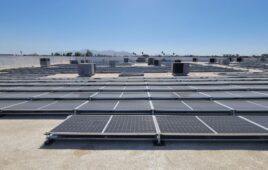By Joel Cannon, SVP of sales and marketing, EnerBank USA
As I visit home improvement contractors nationwide, and perhaps especially in solar, many of them worry about how much cash each client has to pay for the project. While accepting cash only may seem like a good financial strategy upfront, you miss the immediate and long-term opportunities of adding payment options to your sales strategy.
Here’s good news: The solar industry is better than most at using payment options well. In fact, surveys suggest about 80% of solar projects are financed — well beyond other home improvements — because many contractors use payment options to match loan payments below current monthly electricity bills.
It’s a smart way to leverage payment options to your advantage to help homeowners get the solar-powered home of their dreams.
But you could go further…
Another way to maximize payment options and close more sales is to offer same-as-cash as a choice to your customers.
Same-as-cash loans can actually be better than cash because it’s a short-term solution with no monthly payment or interest if paid within the “same-as-cash” period. These loans give customers more flexibility, especially if they want to have the project completed now, but want to conserve near-term cash or use it as a bridge to future income.
For example, a customer may want to install solar panels before the long days of summer or before a local, state or federal tax credit expires. A same-as-cash loan allows the customer to get the project now, knowing expected bonuses, tax refunds, savings or investment returns are coming in the next months that will give them the cash they need to pay off the loan with ease.
Because you offer more flexibility with same-as-cash, you’ll close more business. In fact, we’ve seen a 14% increase in close rates when contractors suggest same-as-cash.
There are several ways to use same-as-cash in your business:
Same-as-cash loan
EnerBank USA offers some solar-specific loans that highlight a same-as-cash loan that has a no-payment, interest-free period if paid off before the promotional period ends.
Same-as-cash and low-monthly-payment loan combo
Additionally, some loans can combine a same-as-cash and a low monthly payment option in a single product. Customers use same-as-cash to finance the amount they expect to receive in tax credits and rebates from the purchase of solar. They finance the remainder with a low-monthly-payment loan with a term of 12 to 20 years.
Same-as-cash and low-monthly-payment loan with re-amortization periods
Other loans combine same-as-cash with a low-monthly-payment loan and up to three amortization periods to deliver maximum advantage to homeowners moving to solar. These loans usually provide a 12- to 18-month period with no payments. Homeowners can pay off the entire loan during this period, and if so, all accrued interest is waived. After the no-payment period, the loan is re-amortized, giving homeowners the option to apply rebates, bonuses or tax refunds to reduce the amount of ensuing payments. These loans can be re-amortized annually as many as three times.
In many cases, re-amortization provides incredible flexibility on how your customers can pay for their solar projects. Let’s say a solar project costs $20,000. On a 12-year loan at 5%, your monthly payment is just under $200. For simplicity’s sake, let’s say your customer expects to receive $5,000 in tax credits within 12 months and also wants to apply $5,000 as a down payment. With the same-as-cash portion, they can hold on to the money and wait until they get the tax rebate or refund. When they receive those payments, they can pay the $10,000 toward the loan. Then, after they pay the $10,000, they can re-amortize on the new loan amount —$10,000. Now the payment is under $100, which they can easily continue to pay for 12 years.
On the other hand, if they wanted to keep the cash from the tax rebate, they can repay the loan with a monthly payment of about $200, based on the original $20,000 amount.
Which option is best for your customers? You can never really know for certain until you ask. The best practice is to outline all the choices for your customers and let them choose the route they like best. Don’t make assumptions about your customers’ ability to pay. Instead, give them possibilities. When you do, you may be surprised how many customers will upgrade their panels or add a storage solution, because you’ve shown them how flexible financing and same-as-cash can help them stretch their budget to achieve more than they thought.
And that, in a nutshell, is how same-as-cash financing is actually better than cash.





Leveraged loans during a period of tax breaks like the remaining 26%, 22% ITC is great. Covid-19 is thoroughly screwing this opportunity up. “Perhaps” legislative extensions may or may not be a saving grace. Folks are way far into the “today” syndrome. Just 15 years ago, solar PV installed was something like $6.50 to $7.00/watt installed. Today one can find solar PV installed for just under $3.00/watt almost anywhere in the U.S.. IF you are the handyman type, there are solar PV kits that can be installed by the owner for a little less than $18k for a 10.5kWp grid tied solar PV system today. For $1.71/watt installed one could have solar PV.